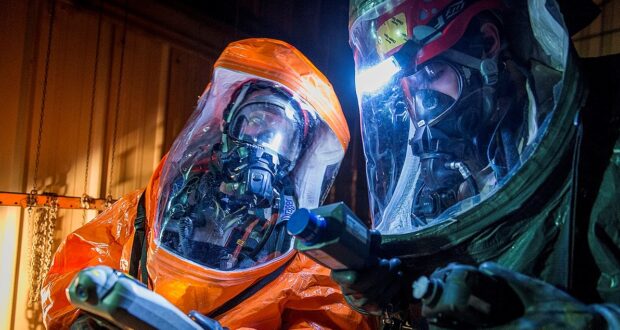26 May, 2021
By Jack Davies – Junior Fellow
COVID-19 has reminded humanity of a once-commonly recognised fact; the danger of pandemics cannot be underestimated. The Black Death killed 25 million people during the 1340s, including a third of all Europeans; the invasion of the Americas 150 years later saw pathogens spread like wildfire through indigenous populations, with up to 90% of the pre-invasion population dying from disease, conflict and their consequences; and smallpox is estimated to have killed 300 million people during the 20th century alone. COVID-19 may not deserve to be listed among these infamous cases, but even with unprecedented global action to limit its spread and treat those infected, it has still killed over 3 million human beings in 2020.
As the US’s Bipartisan Commission on Biodefense warned in its January 2021 report, ‘‘The world can no longer consider a devastating biological event like the COVID-19 pandemic to be a rare, once-in-a-century, occurrence […] Interconnected air travel networks, food production methods, climate and land-use changes, and increasing urbanization and human-wildlife interfaces contribute to the increasing risk and frequency of naturally occurring infectious diseases with pandemic potential.’ Despite incredible advances over the last 100 years in public health and the biosciences, we remain deeply vulnerable to pandemics and other catastrophes.
Pandemics are as old as humanity, but while the increasing likelihood of future pandemics is certainly alarming, it is not the worst-case scenario; a natural pathogen could kill tens or hundreds of millions, a designed or adapted one could threaten civilization collapse, ushering in an engineered apocalypse. Perhaps unsurprisingly, emerging, disruptive and transformational (EDT) biotechnologies and methods such as synthetic biology, genomic and genetic engineering, and biofabrication have therefore become increasing subjects of focus among security and catastrophic risk scholars. Developments within these technologies offer increasingly powerful tools to a widening pool of actors, including those who may consider carrying out a deliberate biological attack.
Breaking Down Barriers
At the core of catastrophic risk from engineered pandemics are a suite of rapidly advancing technologies; including the aforementioned synthetic biology and genomic and genetic engineering. The vast majority of research involving these technologies focuses on achieving social good, for example producing new medicines or more effective crop growth and pest resilience. However, their continued development and ongoing refinement invariably works to produce technological tools with immense capabilities.
It is not just that the technology itself is advancing, although it certainly is: breakthroughs such as the genetic editing tool Clustered Regularly Interspaced Short Palindromic Repeats, or CRISPR-Cas9, are expanding our capabilities for bioengineering, the ‘application of principles and techniques from engineering to biological systems’. The bigger issue is that these advances have been coupled with a rapid ‘democratisation’ of technology, a reduction in the material and institutional cost of access and use.
In theory this should be cause for celebration; certainly, it suggests that more people will have greater access to truly transformational biotechnological capabilities than ever before. For example, the cost of DNA sequencing and synthesis have decreased rapidly, falling by a factor of 10,000 since 2007 from $9 million to roughly $670 in 2019, while sequencing’s counterpart, DNA synthesis, is now available as an online service, with companies offering to construct and ship DNA sequences of the client’s choice. As Oxford University’s Future of Humanity Institute (FH) Senior Research Fellow Toby Ord points out, there has been an acceleration of ‘the speed at which cutting-edge techniques [are] adopted by students and amateurs. When a new breakthrough is achieved, the pool of people with the talent, training, resources and patience to reproduce it expands: from a handful of the world’s top biologists, to people with PhDs in the field, to millions of people with undergraduate-level biology.’
However, these are potentially dangerous technologies that could plausibly be used to cause harm. A perfect storm of reducing the hurdle of expertise, dropping financial costs to DNA sequencing and synthesis and the removal of geographical barriers to use through online services have led to fears that advanced biotechnology and techniques are fast becoming more accessible to individuals operating outside of controllable, relatively secure traditional research labs.
Combined with the existence of readily available open-access copies of sequenced pathogen genomes, not all of which are screened for all the time by online synthesis services, there is an acutely perceived danger of a malicious actor effectively being able to access deadly pathogens at will. In theory, a sufficiently motivated actor may one day even be able to synthesize smallpox, resurrecting the pathogen and erasing humanity’s crowning accomplishment of the 20th century – eradicating it. Indeed, a group of Canadian researchers in 2017 were able to recreate horsepox, a relative of smallpox also believed to no longer exist in the natural world, using pieces ordered online.
The bottom line? Biotechnology has an access problem, but just how likely is it that anyone will actually exploit it?
Doomsday Cults
It is an unfortunate reality that a number of individuals and groups exist within the world with the desire to cause mass genocide, or in some cases human extinction. Some of these are peaceful, for example the Voluntary Human Extinction Movement (VHEMT), a movement that advocates human extinction through depopulation in the name of environmental protection, while others are violent, such as Aum Shinrikyo, which infamously released Sarin gas on the Tokyo subway in 1995. Aum Shinrikyo are also reported to have attempted to weaponize anthrax, though without success. Violent terrorist organisations (VEOs) such as Daesh have long been thought incapable of acquiring advanced biological weapons, however the democratisation of biotechnology is putting potentially catastrophic capabilities within reach. Would a VEO hesitate to use an engineered bioweapon? Would a rogue state facing imminent invasion?
Risk modelling suggests that as the barriers to access decrease, the relative risk of a catastrophic biological event being perpetrated by a lower-powered actor quickly eclipses that from a more powerful actor (e.g. a state). More research is needed to better understand how common doomsday cults that have the will to follow through on threats of omnicide (human extinction) actually are. Thankfully, they seem to be rare. Yet even a single individual releasing a single sample of revived smallpox or enhanced influenza could begin a spiral that leads to global pandemic, and the ever-widening group of people with access to the means to create such a pandemic will surely one day overlap with the group of people with the will to do so.
However, even if humanity is able to collectively control access to pathogens, ensuring that only reputable, secure labs are able to experiment with them, we are still not safe from engineered pandemics. Intentional malicious exposure is only one path to an outbreak – the other, perhaps even more major, is through accidental exposure.
Accidental Outbreaks
During the 20th century numerous states established bioweapons programmes, including the US, UK, France, Japan and the USSR. Of these the USSR’s was by far the largest, consisting at its height of ‘more than a dozen clandestine labs employing 9,000 scientists to weaponize diseases ranging from plague to smallpox, anthrax and tularaemia.’ Common alterations included increasing the transmissibility, lethality, or resistance of a pathogen – experiments termed ‘gain-of-function’ (GOF). Most of these programmes have since been shut down in accordance with the Biological Weapons Convention, however a small amount of GOF research involving these deadly pathogens continues to this day.
Needless to say, GOF research is incredibly risky. It takes an already dangerous pathogen and super-charges it, breaking the transmissibility-lethality offset that appears to have kept natural pandemics from destroying humanity until now. One well-known example is that of virologist Ron Fouchier, who in 2012 released a GOF study detailing how, through genetic engineering and serial infection of ferrets, he and his team had successfully mutated a highly lethal strain of the H5N1 avian influenza virus (which killed 60% of humans it infected) to gain airborne transmissibility among mammals. The Fouchier case raises the question of how far programme leaders within biosciences labs should be able to operate autonomously, to undertake and perform GOF research without extensive governmental review and approval.
Fouchier’s H5N1 remained contained within his lab, however the accidental escape of dangerous pathogens from supposedly highly secure labs is shockingly common. The aforementioned Soviet bioweapons programme was notoriously accident-prone, with high-profile smallpox and anthrax outbreaks in 1971 and 1979 respectively. In 2014, as the US’s Food and Drug Administration (FDA) were moving to a new building, 6 vials of smallpox were discovered that had been forgotten since the 1960s. The nightmare scenario of smallpox being resurrected has in fact already happened in 1978 when, only a year after the world was first declared smallpox free, a version of the virus escaped a poorly run lab in Birmingham, UK. Almost 30 years later foot-and-mouth, considered a highest biosafety category pathogen, escaped from a lab, leaking into the groundwater below. The labs safety licence was renewed following an investigation, only for a second leak to happen two weeks later.
Based on recent history, the escape of an enhanced pathogen seems alarmingly plausible. In many of the above cases luck played a major role in allowing authorities to quickly identify and control exposure to the escaped pathogen, limiting its spread. The problem with luck is that it eventually runs out.
Just how likely is an engineered apocalypse?
The good news is that biosecurity is a fast-growing field, with numerous actors engaged in the challenges posed by advancing biotechnologies, the democratisation of technology and GOF research across a range of lenses, most prominently through technological and policy spheres.
The previously mentioned FHI seeking to expand its research groups to include both ‘Technology and Wisdom’ (understanding which technological paths to pursue) and ‘Reducing Risk from Malevolent Humans’ (defining and operationalising personality traits of potential concern and evaluating possible intervention strategies), beginning the process of uncovering the reality behind doomsday cults and how to mitigate the risk of democratisation of technology. The Bipartisan Commission for Biodefense’s Apollo Programme for Biodefense report focuses on augmentations to existing frameworks, such as the U.S. Health and Human Services (HHS) P3CO Framework, ‘Framework for Guiding Funding Decisions about Proposed Research Involving Enhanced Potential Pandemic Pathogens (PPP)’, which guides funding decisions on proposed GOF research. The report’s recommendations include: (1) pathogen transmission suppression in the built environment, (2) comprehensive laboratory biosafety regulation, and (3) technologies to deter and prevent bad actors.
In addition to policy and regulatory frameworks, biotechnology itself may hold the keys to reducing risk. Former US Assistant Secretary of Defense responsible for biological and other weapons of mass destruction Andy Weber claims that current generation tools ‘enable the possibility of making bioweapons obsolete’. Weber points to mass genetic sequencing and mRNA vaccines as revolutionising detection of pathogens and production of vaccines. This perspective is shared by the Bipartisan Commission for Biodefense, which articulated a vision, of ‘a world where we detect and continually trace any new pathogen from the source; where we can distribute rapid point-of-person tests to every household in the country within days of that detection; where effective treatments are already in-hand; where vaccine development and rollout occur in weeks rather than years; and where pandemics will never again threaten [humanity]’.
There is a real and deeply alarming danger of an engineered pandemic, intentional or accidental, occurring in the future; whether it does will depend in part on how we approach the balance between technological development, scientific freedom and security. No matter how we tackle this challenge we will need to make proactive, decisive, and wise decisions. The best place to begin is surely to recognise our precarious position, and to decide to change it.
 Human Security Centre Human Rights and International Security Research
Human Security Centre Human Rights and International Security Research




